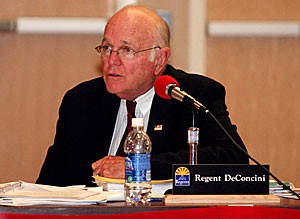The Arizona Board of Regents passed a 5 percent tuition increase for Arizona residents at its meeting yesterday.
The figure amounts to a base tuition hike of $230 for undergraduates and $264 forgraduate students.
A student-backed proposal of 2.3 percent, introduced by Regent Dennis DeConcini, failed by a vote of six votes to four. President Robert Shelton’s 6.5 percent-proposed increase was also rejected.
Instead regents opted for a compromise between the two, introduced by Regent Fred Boice, that passed by a seven-vote majority.
Nonresidents will see a tuition hike of 8.5 percent, the amount Shelton proposed.
Discussion about mandatory fees, like a controversial $65 addition to the UA technology fee, was delayed until the regents’ next meeting in January.
The Arizona Students’ Association called for tuition to increase by 2.3 percent – on the condition that state legislators approve a $150 million increase to the university system, from which each institution would have seen an 8 percent total budget increase.
Had state lawmakers not matched those numbers, student leaders would have supported their presidents’ proposals.
Student Regent Ed Hermes said he was disappointed by the regents’ eventual decision.
“”We had the opportunity to do something innovative, something great, this year, and it didn’t happen,”” said Hermes, an Arizona State University student.
Devin Mauney, ASA chair, said he had hoped to see a shift in the way regents look at setting tuition, but this year’s decision keeps the process “”in a rut.””
“”It’s hard to change directions on a vessel so large as the Arizona university system,”” said Mauney, an economics sophomore at ASU.
But Mauney said he was happy the ASA plan got as many votes as it did, because student proposals usually don’t get much support.
“”It’s not all a dark day, definitely not,”” Mauney said.
Shelton said he would have preferred to see his proposal pass, but he is glad the board left an understanding that legislators would provide $2.9 million toward state financial aid.
“”That would be a great outcome,”” Shelton said. “”I would be very pleased with that.””
Such an amount would make up the difference between Shelton’s proposal and the one regents eventually accepted because about 30 percent of tuition money goes to financial aid anyway.
Paul Thorn, president of the Graduate and Professional Student Council, said he was not surprised by the eventual outcome of the vote.
Thorn said student leaders spoke several times with individual regents about trying to push the proposal through, so they had an idea of how each one was going to vote.
A few regents raised concerns that the student proposal would be too risky to adopt.
Regent Gary Stuart worried about “”the high risk of negotiating with the Legislature using tuition as a quid pro quo.””
Regent Anne Mariucci said the board would have put itself in a risky situation if it were to depend on the Legislature to provide the $150 million stipulated amount.
But DeConcini noted that the student proposal would have deferred to the presidents’ higher proposals if lawmakers didn’t pass the required funding.
“”Students bear the burden if the Legislature doesn’t perform,”” DeConcini said. “”They’re taking the risk.””
Thorn said the initial idea for the student proposal came from DeConcini.
Stuart raised another concern, saying that the proposal would have the unintended consequence of unlinking tuition and financial aid.
Boice said making those two things more closely related is one of his goals for the future, though his compromise doesn’t address the issue “”in a significant way.””
While Boice said he did not support the student plan, he was impressed with how the students organized it, saying that previous student leaders have had proposals that were “”dramatic but not substantive.””
Regent Fred DuVal said the student leaders’ work has produced results in the state Legislature, even though their proposal did not pass.
Having new clout in the statehouse will help in the future because students are badly needed to influence some decisions like state aid for low-income students, he said.
“”The rate of state financial aid is an embarrassment, really,”” Thorn said.
Associated Students of the University of Arizona President Erin Hertzog said students may not be as inclined to lobby their representatives now that the student proposal has failed, but the ASA will not give up in its efforts to pass legislation.
“”That’s something you can continue to expect,”” Hertzog said.









